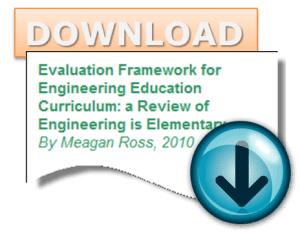 This paper introduces a framework and rubric for evaluation of K-12 engineering education curriculum, based on engineering education literature and the Wiggins & McTighe process known as Backwards Design. [First identify desired results, then determine acceptable evidence, and finally plan learning experiences and instruction.] This process is an alignment of content, assessment, and pedagogy, the three components used as the measure of quality programmatic elements. (skip to page 3 for the framework)
This paper introduces a framework and rubric for evaluation of K-12 engineering education curriculum, based on engineering education literature and the Wiggins & McTighe process known as Backwards Design. [First identify desired results, then determine acceptable evidence, and finally plan learning experiences and instruction.] This process is an alignment of content, assessment, and pedagogy, the three components used as the measure of quality programmatic elements. (skip to page 3 for the framework)
The rubric defined in this paper will be useful to teachers, administrators, and curriculum developers of engineering education curriculum.
Engineering is Elementary is the curriculum reviewed as an example of the application of the framework/rubric. This work was developed as an assignment for a graduate course at Purdue University, under the instruction of Dr. Johannes Strobel.

